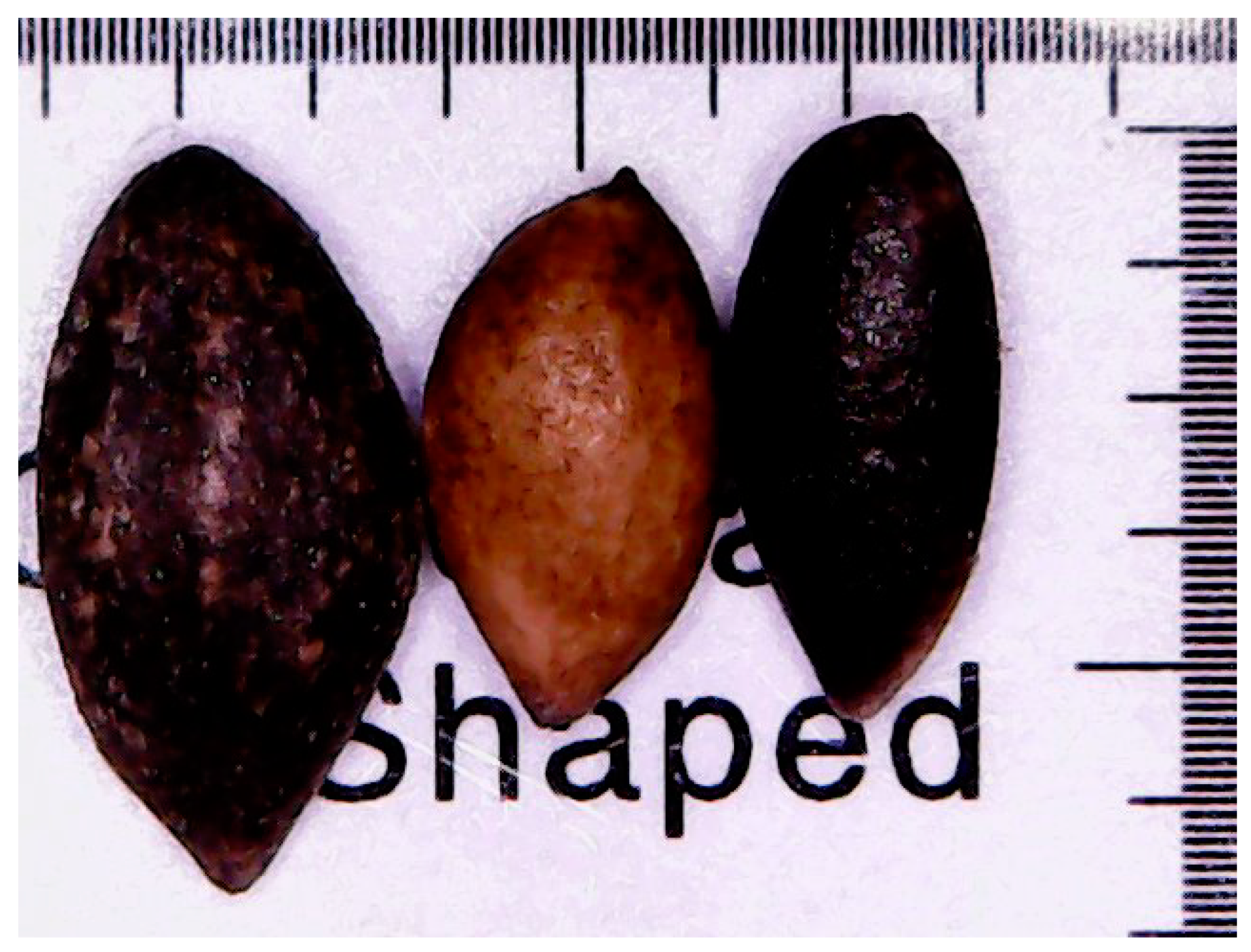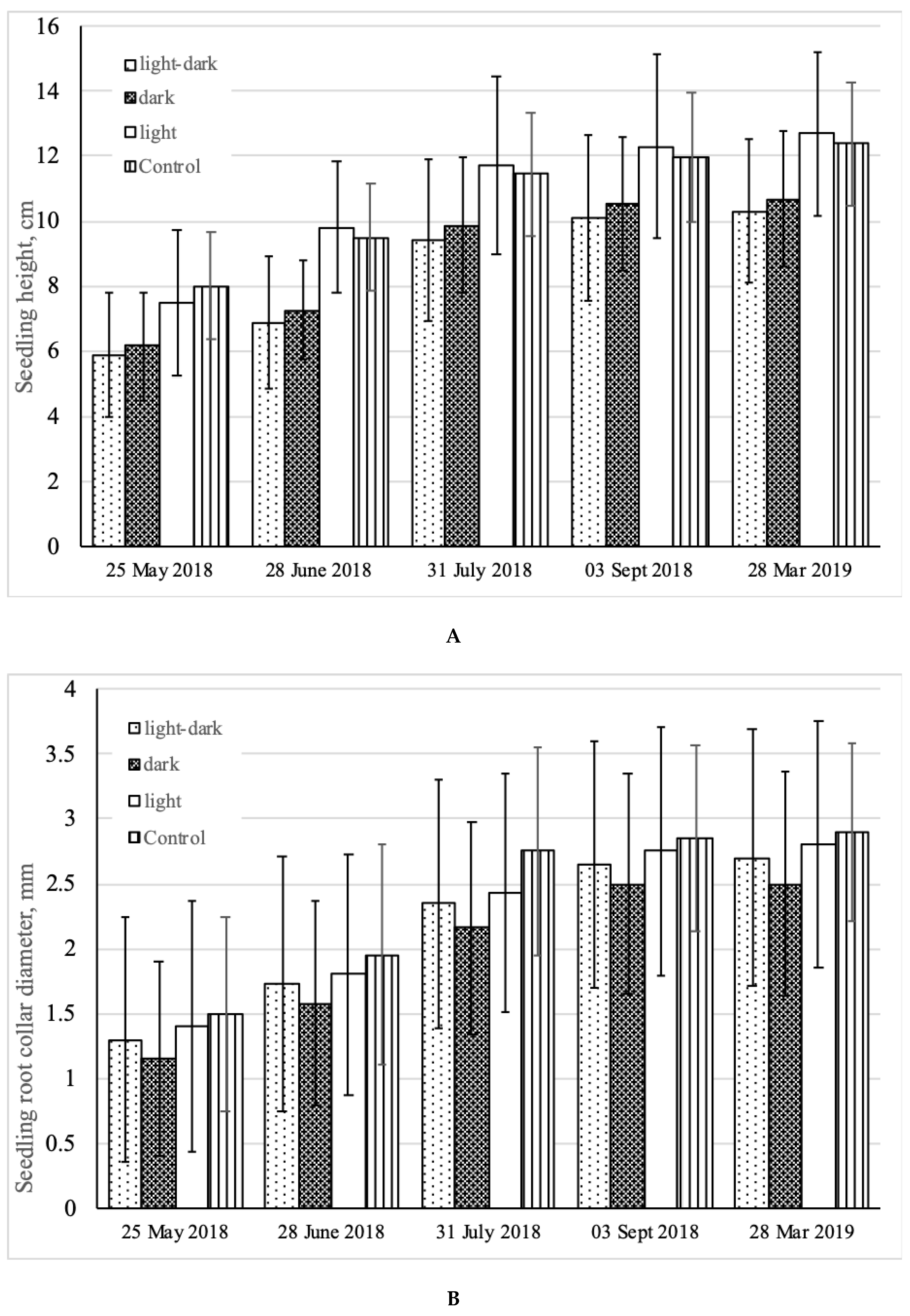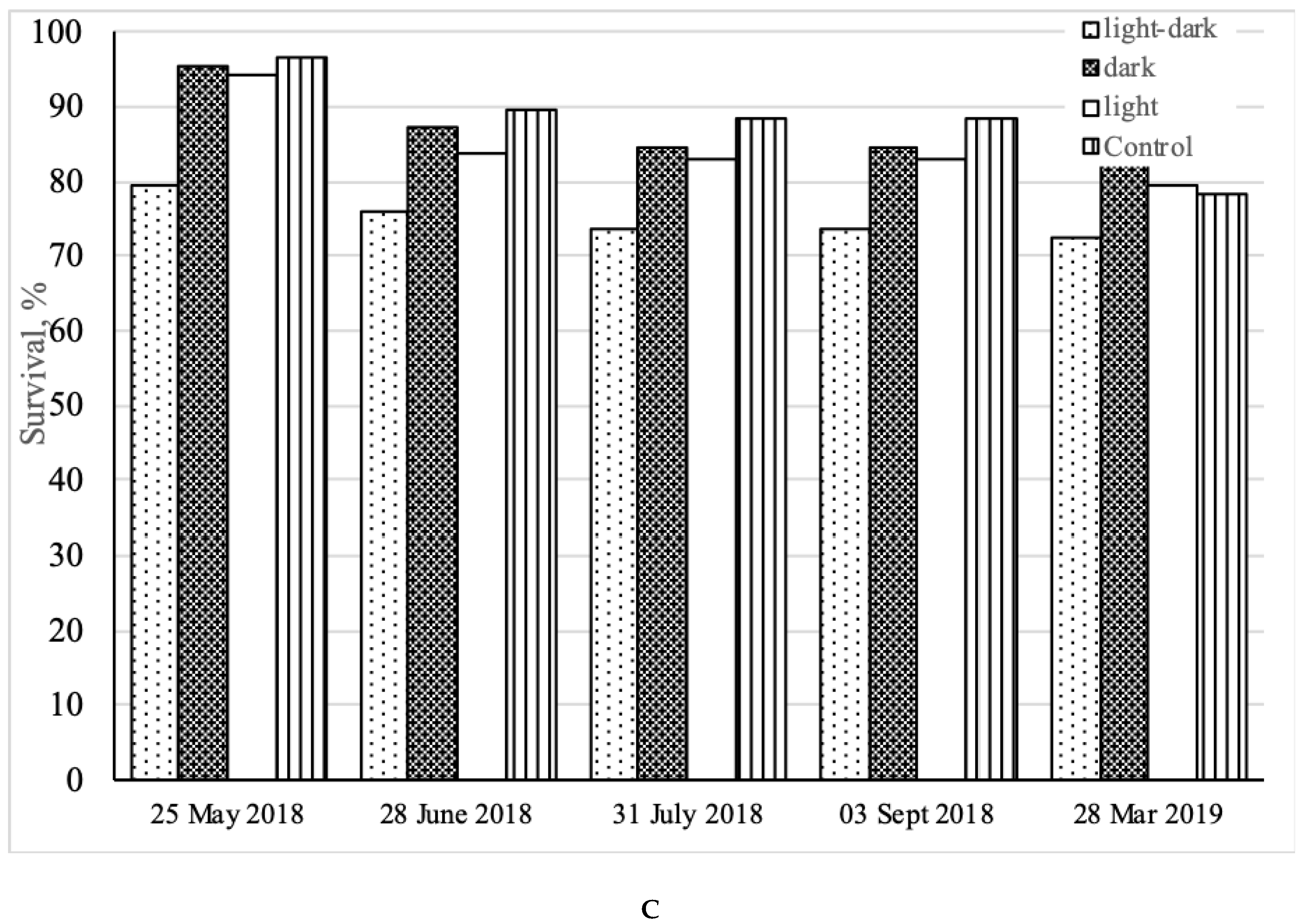Performance of Scots Pine Seedlings from Seeds Graded by Colour
Abstract
1. Introduction
2. Materials and Methods
2.1. Seed Coat Colour Grading
2.2. Experimental Site, Experimental Design, and Planting Method
2.3. Meteorological Conditions during the Study
2.4. Data Collecting and Processing
3. Results
4. Discussion
5. Conclusions
- Pinus sylvestris L. seedlings produced from light seed fraction grow better in height, compared to other colour fractions, with an average survival rate;
- Light-dark seeds, which constitute the largest group in the initial sample by absolute weight, results with Pinus sylvestris L. seedlings of the lowest growth rates and survival;
- Dark seed fraction, which had the lowest partition in the initial sample, resulted with seedlings of the highest survival rate.
- The good results showed by seedlings from the control, for both growth rates and survival, indicate the weak effect of seed colour grading on seedlings field performance.
- For the present dataset, the conclusion points at a potentially strengthened hypothesis for a future study rather being conclusive in itself.
Author Contributions
Funding
Acknowledgments
Conflicts of Interest
References
- Stanturf, J.A.; Palik, B.J.; Dumroese, R.K. Contemporary forest restoration: A review emphasizing function. For. Ecol. Manage. 2014, 331, 292–323. [Google Scholar] [CrossRef]
- Löf, M.; Madsen, P.; Metslaid, M.; Witzell, J.; Jacobs, D.F. Restoring forests: Regeneration and ecosystem function for the future. New For. 2019, 50, 139–151. [Google Scholar] [CrossRef]
- Ivetić, V.; Devetaković, J.; Maksimović, Z. Initial height and diameter are equally related to survival and growth of hardwood seedlings in first year after field planting. Reforesta 2016, 2, 6–21. [Google Scholar] [CrossRef]
- Ivetić, V.; Grossnickle, S.; Škorić, M. Forecasting the field performance of Austrian pine seedlings using morphological attributes. iForest Biogeosciences For. 2016, 10, 99–107. [Google Scholar] [CrossRef]
- Grossnickle, S.C.; Ivetić, V. Direct Seeding in Reforestation—A Field Performance Review. Reforesta 2017, 4, 94–142. [Google Scholar] [CrossRef]
- Myking, T.; Rusanen, M.; Steffenrem, A.; Kjær, E.D.; Jansson, G. Historic transfer of forest reproductive material in the Nordic region: Drivers, scale and implications. Forestry 2016, 89, 325–337. [Google Scholar] [CrossRef]
- Jansen, S.; Konrad, H.; Geburek, T. Crossing borders—European forest reproductive material moving in trade. J. Environ. Manage. 2019, 233, 308–320. [Google Scholar] [CrossRef] [PubMed]
- Yablokov, A.S. Forest Seed Production (Lesosemennoe Khozyaystv); Forest Industry Publishing: Moscow, Russia, 1965; p. 266. (In Russian) [Google Scholar]
- Ivetić, V.; Devetaković, J. Concerns and evidence on genetic diversity in planted forests. Reforesta 2017, 3, 196–207. [Google Scholar] [CrossRef]
- Kaliniewicz, Z.; Tylek, P. Influence of Scarification on the Germination Capacity of Acorns Harvested from Uneven-Aged Stands of Pedunculate Oak (Quercus robur L.). Forests 2018, 9, 100. [Google Scholar] [CrossRef]
- Drapalyuk, M.V.; Novikov, A.I. Analysis of operational mechanized technologies of seed separation under artificial forest restoration. For. Eng. J. 2018, 8, 207–220. (In Russian) [Google Scholar]
- Novikov, A.I.; Ivetić, V. The effect of seed coat color grading on height of one-year-old container-grown Scots pine seedlings planted on post-fire site. IOP Conf. Ser. Earth Environ. Sci. 2019, 226, 012043. [Google Scholar] [CrossRef]
- Ivetić, V. Handbook on Seed Production, Seedling Production and Afforestation; University of Belgrade, Faculty of Forestry: Belgrade, Serbia, 2013; p. 213. [Google Scholar]
- Ivetić, V.; Devetaković, J.; Nonić, M.; Stanković, D.; Šijačić-Nikolić, M. Genetic diversity and forest reproductive material—From seed source selection to planting. iForest Biogeosciences For. 2016, 9, 801–812. [Google Scholar] [CrossRef]
- Novikov, A.I.; Ersson, B.T. Aerial seeding of forests in Russia: A selected literature analysis. IOP Conf. Ser. Earth Environ. Sci. 2019, 226, 012051. [Google Scholar] [CrossRef]
- Pravdin, L.F. The main regularities of the geographical variability of Scots pine (Pinus sylvestris L.). In Fundamentals of Forest Science and Forestry; Forestry Publishing: Moscow, Russia, 1960; pp. 245–250. (In Russian) [Google Scholar]
- Grzywacz, A.P.; Rosochacka, J. The colour of Pinus silvestris L. seed and their susceptibility to damping-off. I. The colour and quality of seeds and fatty acids content of the seed coat. For. Pathol. 1980, 10, 138–144. [Google Scholar] [CrossRef]
- Rosochacka, J.; Grzywacz, A.P. The colour of Pinus silvestris L. seeds and their susceptibility to damping-off. II. Colour of seed coats and their chemical composition. For. Pathol. 1980, 10, 193–201. [Google Scholar] [CrossRef]
- Mamaev, S.A. Forms of Intraspecific Variability of Woody Plants (on the Example of Pinaceae Family in the Urals); Science Publishing: Moscow, Russia, 1973; p. 284. (In Russian) [Google Scholar]
- Boelt, B.; Shrestha, S.; Salimi, Z.; Jørgensen, J.R.; Nicolaisen, M.; Carstensen, J.M. Multispectral imaging—A new tool in seed quality assessment? Seed Sci. Res. 2018, 28, 222–228. [Google Scholar] [CrossRef]
- Kaliniewicz, Z.; Tylek, P.; Markowski, P.; Anders, A.; Rawa, T.; Jóźwiak, K.; Fura, S. Correlations between the germination capacity and selected physical properties of scots pine (Pinus sylvestris L.) seeds. Balt. For. 2013, 19, 201–211. [Google Scholar]
- Myczko, Ł.; Skórka, P.; Dylewski, Ł.; Sparks, T.H.; Tryjanowski, P. Color mimicry of empty seeds influences the probability of predation by birds. Ecosphere 2015, 6, 1–7. [Google Scholar] [CrossRef]
- Lestander, T.A.; Odén, P.C. Separation of viable and non-viable filled Scots pine seeds by differentiating between drying rates using single seed near infrared transmittance spectroscopy. Seed Sci. Technol. 2002, 30, 383–392. [Google Scholar]
- Novikov, A.I.; Novikova, T.P. Non-destructive quality control of forest seeds in globalization: Problems and prospects of output innovative products. In Proceedings of the Globalization and Its Socio-Economic Consequences, Rajecke Teplice, Slovakia, 10–11 October 2018; pp. 1260–1267. [Google Scholar]
- Novikov, A.I. Visible wave spectrometric features of scots pine seeds: The basis for designing a rapid analyzer. IOP Conf. Ser. Earth Environ. Sci. 2019, 226, 012064. [Google Scholar] [CrossRef]
- Novikov, A.I.; Saushkin, V.V. Infrared range spectroscopy: The study of the pine seed coat parameters. For. Eng. J. 2018, 8, 30–37. (In Russian) [Google Scholar]
- Tigabu, M.; Daneshvar, A.; Jingjing, R.; Wu, P.; Ma, X.; Odén, P.C. Multivariate Discriminant Analysis of Single Seed Near Infrared Spectra for Sorting Dead-Filled and Viable Seeds of Three Pine Species: Does One Model Fit All Species? Forests 2019, 10, 469. [Google Scholar] [CrossRef]
- Farhadi, M.; Tigabu, M.; Pietrzykowski, M.; Danusevičius, D.; Odén, P.C. Application of near infrared spectroscopy for authentication of Picea abies seed provenance. New For. 2017, 48, 629–642. [Google Scholar] [CrossRef]
- Mukassabi, T.A.; Polwart, A.; Coleshaw, T.; Thomas, P.A. Does Scots pine seed colour affect its germination? Seed Sci. Technol. 2012, 40, 155–162. [Google Scholar] [CrossRef]
- Udval, B.; Batkhuu, N.-O. Seed and cone characteristics of Scots pine (Pinus sylvestris L.) from diverse seed sources in northern Mongolia. Eurasian J. For. Res. 2013, 16, 57–62. [Google Scholar]
- Tillman-Sutela, E.; Kauppi, A. The morphological background to imbibition in seeds of Pinus sylvestris L. of different provenances. Trees 1995, 9, 123–133. [Google Scholar] [CrossRef]
- Konovalov, N.A.; Pugach, E.A. The Basis of Forest Breeding and Varietal Seed Production; Forest Industry Publishing: Moscow, Russia, 1978; p. 176. (In Russian) [Google Scholar]
- Albekov, A.U.; Drapalyuk, M.V.; Morkovina, S.S.; Vovchenko, N.G.; Novikov, A.I.; Sokolov, S.V.; Novikova, T.P. Express Analyzer of Seed Quality. RU Patent 2,675,056, 14 December 2018. [Google Scholar]
- Albekov, A.U.; Drapalyuk, M.V.; Morkovina, S.S.; Vovchenko, N.G.; Novikov, A.I.; Sokolov, S.V.; Novikova, T.P. Device for Seeds Sorting. RU Patent 2,682,854, 21 March 2019. [Google Scholar]
- Sokolov, S.V.; Novikov, A.I. New optoelectronic systems for express analysis of seeds in forestry production. For. Eng. J. 2019, 9, 5–13. (In Russian) [Google Scholar]
- Sokolov, S.V.; Kamenskij, V.V.; Novikov, A.I.; Ivetić, V. How to increase the analog-to-digital converter speed in optoelectronic systems of the seed quality rapid analyzer. Inventions 2019, 4, 61. [Google Scholar] [CrossRef]
- Novikov, A.I.; Drapalyuk, M.V.; Dornyak, O.R.; Zelikov, V.A.; Ivetić, V. The Effect of Motion Time of a Scots Pine Single Seed on Mobile Optoelectronic Grader Efficiency: A Mathematical Patterning. Inventions 2019, 4, 55. [Google Scholar] [CrossRef]
- Tinus, R.W. Effects of dewinging, soaking, stratification, and growth regulators on germination of green ash seed. Can. J. For. Res. 1982, 12, 931–935. [Google Scholar] [CrossRef]
- Douglas, J.L.; Grabowski, J.M.; Keith, B.C. A comparison of seed cleaning techniques for improving quality of eastern gamagrass seed. SEED Sci. Technol. 2000, 28, 163–167. [Google Scholar]
- Bondartsev, A.S. Color Scale (Manual for Biologists in Scientific and Applied Research); USSR Academy of Sciences Publishing: Moscow, Russia, 1954; p. 28. (In Russian) [Google Scholar]
- Novikov, A.I. Rapid Analysis of Forest Seeds: Biophysical Methods; VSUFT Publishing: Voronezh, Russia, 2018; p. 128. ISBN 978-5-7994-0869-5. (In Russian) [Google Scholar]
- Montagnoli, A.; Terzaghi, M.; Fulgaro, N.; Stoew, B.; Wipenmyr, J.; Ilver, D.; Rusu, C.; Scippa, G.S.; Chiatante, D. Non-destructive phenotypic analysis of early stage tree seedling growth using an automated stereovision imaging method. Front. Plant Sci. 2016, 7, 1644. [Google Scholar] [CrossRef] [PubMed]
- Mohamed-Yasseen, Y.; Barringer, S.A.; Splittstoesser, W.E.; Costanza, S. The role of seed coats in seed viability. Bot. Rev. 1994, 60, 426–439. [Google Scholar] [CrossRef]
- Nystrand, O.; Granström, A. Post-dispersal predation on Pinus sylvestris seeds by Fringilla spp.: ground substrate affects selection for seed color. Oecologia 1997, 110, 353–359. [Google Scholar] [CrossRef]
- Cram, W.H.; Lindquist, C.H. Maturity of Scots pine cones. For. Chron. 1979, 55, 170–174. [Google Scholar] [CrossRef]
- Mexal, J.G.; Landis, T.D. Target seedling concepts: Height and diameter. In Proceedings of the Target Seedling Symposium: Proceedings, Combined Meeting of the Western Forest Nursery Associations; Rose, R., Campbell, S.J., Landis, T.D., Eds.; U.S. Department of Agriculture, Forest Service, Rocky Mountain Forest and Range Experiment Station: Fort Collins, CO, USA, 1990; pp. 17–35. [Google Scholar]
- Thompson, B.E. Seedling morphological evaluation: What you can tell by looking. In Proceedings of the Evaluating Seedling Quality: Principles, Procedures, and Predictive Ability of Major Tests; Durvea, M.L., Ed.; Forest Research Laboratory, Oregon State University: Corvallis, OR, USA, 1985; pp. 59–72. [Google Scholar]
- Mattsson, A. Predicting field performance using seedling quality assessment. New For. 1996, 13, 223–248. [Google Scholar]
- Chavasse, C.G.R. The significance of planting height as an indicator of subsequent seedling growth [forest and ornamental trees]. N. Z. J. For. 1977, 22, 283–296. [Google Scholar]
- Ivetić, V.; Devetaković, J. Reforestation challenges in Southeast Europe facing climate change. Reforesta 2016, 178–220. [Google Scholar] [CrossRef]
- Novikov, A.I.; Ivetić, V. The effect of seed size grading on seed use efficiency and height of one-year-old container-grown Scots pine (Pinus sylvestris L.) seedlings. Reforesta 2018, 6, 100–109. [Google Scholar] [CrossRef]
- Novikov, A.I.; Ivetić, V.; Novikova, T.P.; Petrishchev, E.P. Scots Pine Seedlings Growth Dynamics Data Reveals Properties for the Future Proof of Seed Coat Color Grading Conjecture. Data 2019, 4, 106. [Google Scholar] [CrossRef]
- Cristan, R.; Aust, W.M.; Bolding, M.C.; Barrett, S.M.; Munsell, J.F.; Schilling, E. Effectiveness of forestry best management practices in the United States: Literature review. For. Ecol. Manage. 2016, 360, 133–151. [Google Scholar] [CrossRef]
- Cleland, T.M. Practical Description of the Munsell Color System, With Suggestions for its Use; Munsell Color Co.: Boston, MA, USA, 1921; p. 27. [Google Scholar]
- Tikhonova, I.V.; Tarakanov, V.V.; Tikhonova, N.A.; Barchenkov, A.P.; Ekart, A.K. Population variability of cones and seeds of scots pine by phenes of color and traits-indices in the south of Siberia. Contemp. Probl. Ecol. 2014, 7, 60–66. [Google Scholar] [CrossRef]
- Albekov, A.U.; Drapalyuk, M.V.; Morkovina, S.S.; Novikov, A.I.; Vovchenko, N.G.; Sokolov, S.V.; Novikova, T.P. Seed Sorting Device. RU Patent 2,687,509, 14 May 2019. [Google Scholar]



| Seed Colour Class (VIS-spectroscopy) [25] | Organoleptic Method [40] | Munsell (CMYKOG) Colour System | Seed Mass in g (total of 1600 g) | ||
|---|---|---|---|---|---|
| Name | VIS Wavelenth Range, nm | Degree of Reflection, % | |||
| 1—Light | 650–715 | 70–85 | Lutescens | 4.9 Y 7.5/4.2 (C0, M0, Y35, K26, Or10, G0) | 376 |
| 2—Light-dark | 650–715 | 50–65 | Ochraceus | 9.8YR 6.0/4.1 (C0, M0, Y14, K40, Or36, G6) | 1002 |
| 3—Dark | 650–715 | 35–45 | Brunneus | 7.3YR 2.6/1.7 (C63, M70, Y85, K54, Or0, G0) | 134 |
| Control | bulk | bulk | bulk | bulk | 88 |
| Month | Average Temperature, °C (Mean±SE) | Temperature Normal Ratio, °C | Rainfall, mm | Rainfall Normal Ratio, mm |
|---|---|---|---|---|
| May 2018 | 15.18 ± 0.28 | 14.8 | 22 | 44 |
| June 2018 | 18.22 ± 0.23 | 18.5 | 42 | 67 |
| July 2018 | 20.45 ± 0.16 | 20.5 | 26 | 72 |
| August 2018 | 19.69 ± 0.31 | 19.2 | 17 | 55 |
| September 2018 | 13.33 ± 0.33 | 13.3 | 28 | 53 |
| Characteristics | Seed Colour Classes | Root Collar Diameter, mm | Shapiro–Wilk’s W | Height, cm | Shapiro–Wilk’s W |
|---|---|---|---|---|---|
| The average values (Mean±SE). Mean values followed by the different letter are statistically different (p < 0.05). | Control | 2.9 ± 0.08 | W = 0.95085, p = 0.00598 | 12.4 a ± 0.22 | W = 0.98059, p = 0.31342 |
| 1—Light | 2.8 ± 0.12 | W = 0.92449, p = 0.00051 | 12.7 a ± 0.31 | W = 0.95540, p = 0.01611 | |
| 2—Light-dark | 2.7 ± 0.13 | W = 0.89588, p = 0.00012 | 10.3 b ± 0.29 | W = 0.95251, p = 0.02376 | |
| 3—Dark | 2.5 ± 0.1 | W = 0.96631, p = 0.05341 | 10.7 b ± 0.25 | W = 0.95077, p = 0.01739 | |
| Survival, % | Control | 78.2 | |||
| 1 | 79.3 | ||||
| 2 | 72.3 | ||||
| 3 | 83.5 | ||||
| Title | SS | df | MS | F | p |
|---|---|---|---|---|---|
| Height, cm | 313.01 | 3 | 104.34 | 20.602 | 0.00000 |
© 2019 by the authors. Licensee MDPI, Basel, Switzerland. This article is an open access article distributed under the terms and conditions of the Creative Commons Attribution (CC BY) license (http://creativecommons.org/licenses/by/4.0/).
Share and Cite
Novikov, A.; Sokolov, S.; Drapalyuk, M.; Zelikov, V.; Ivetić, V. Performance of Scots Pine Seedlings from Seeds Graded by Colour. Forests 2019, 10, 1064. https://doi.org/10.3390/f10121064
Novikov A, Sokolov S, Drapalyuk M, Zelikov V, Ivetić V. Performance of Scots Pine Seedlings from Seeds Graded by Colour. Forests. 2019; 10(12):1064. https://doi.org/10.3390/f10121064
Chicago/Turabian StyleNovikov, Arthur, Sergey Sokolov, Michael Drapalyuk, Vladimir Zelikov, and Vladan Ivetić. 2019. "Performance of Scots Pine Seedlings from Seeds Graded by Colour" Forests 10, no. 12: 1064. https://doi.org/10.3390/f10121064
APA StyleNovikov, A., Sokolov, S., Drapalyuk, M., Zelikov, V., & Ivetić, V. (2019). Performance of Scots Pine Seedlings from Seeds Graded by Colour. Forests, 10(12), 1064. https://doi.org/10.3390/f10121064






